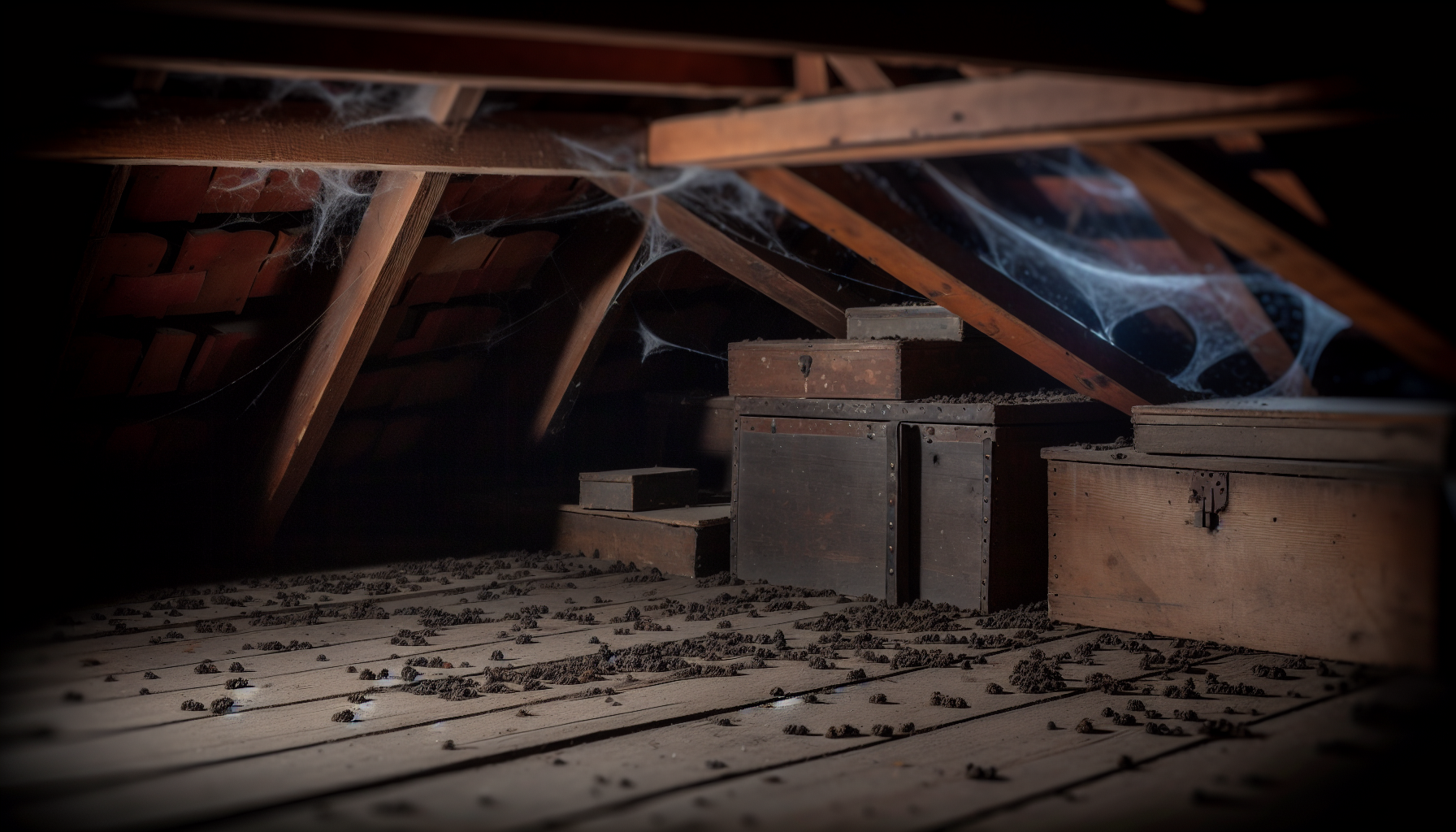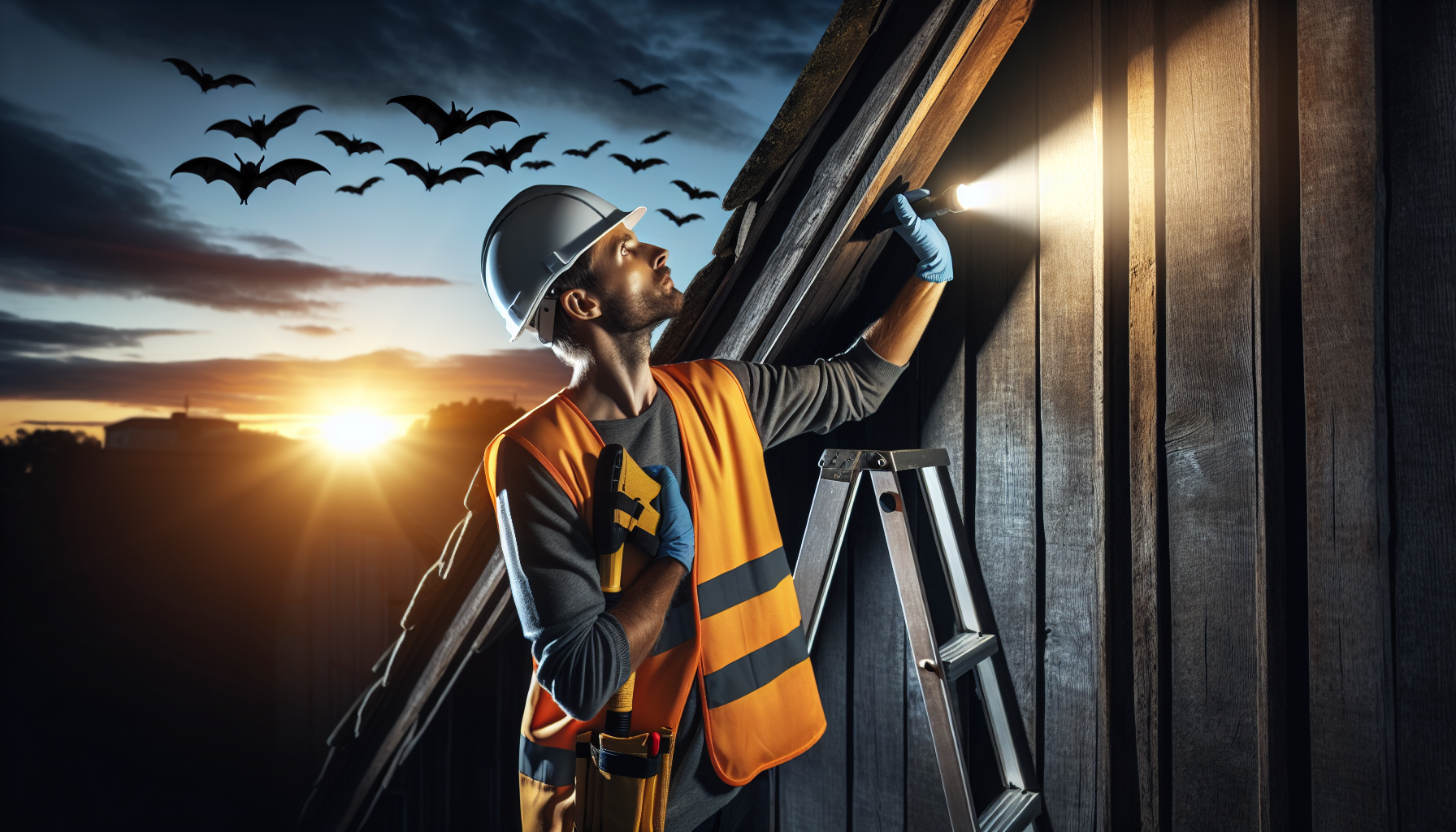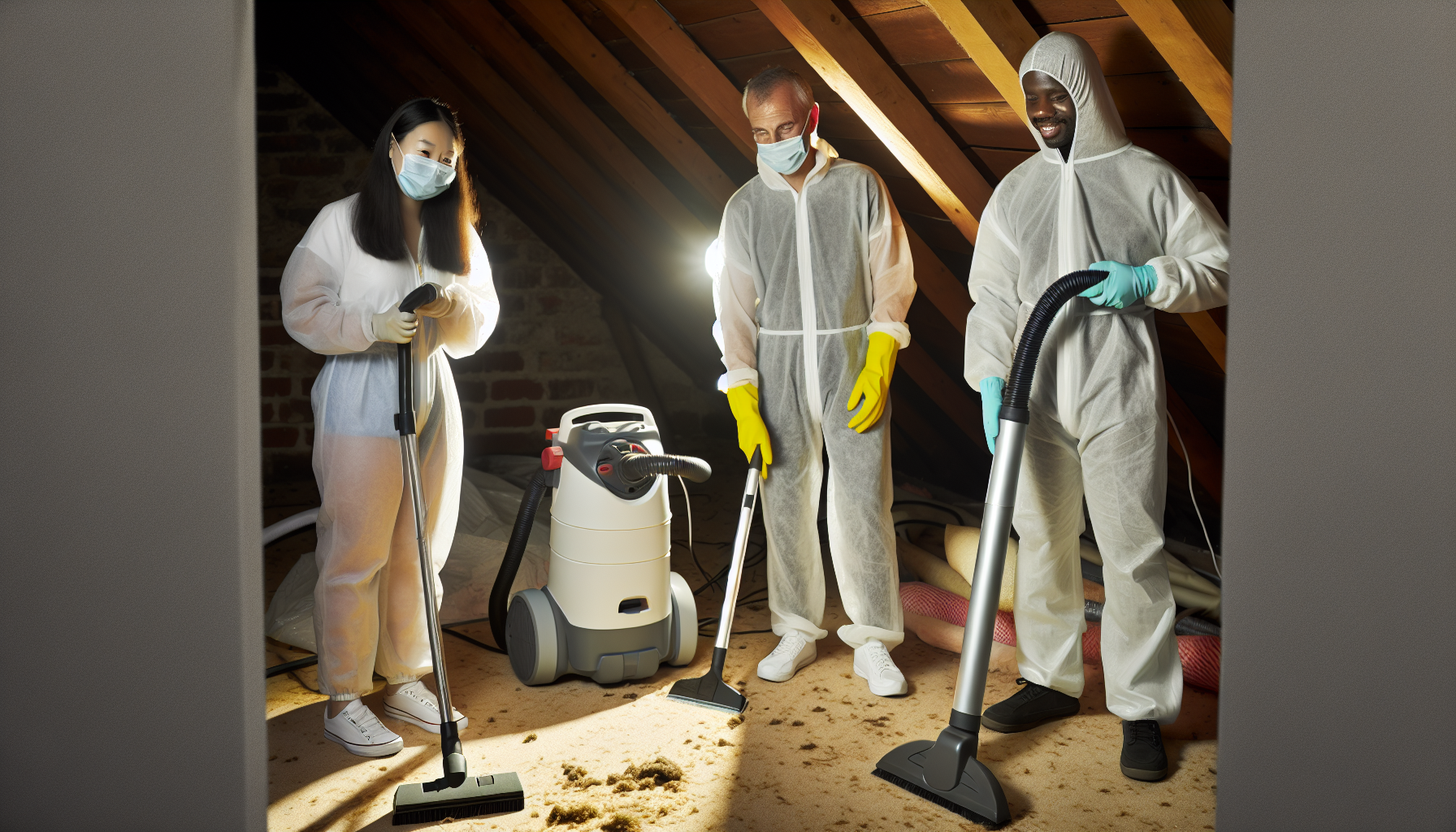Effective Bat Removal: A Step-by-Step Guide to Safely Clear Your Space
Imagine settling into your cozy living room one evening, only to hear an unfamiliar scratching noise coming from above. As the eerie sound continues, you investigate and stumble upon a less than pleasant surprise – a bat infestation! An unexpected encounter with these flying mammals can be quite unsettling, and understandably so. Bats are known to pose various health risks and can cause significant damage to your property. Equipping yourself with knowledge on this subject is your first line of defense. So, let’s embark on this journey of understanding bat infestations and how to handle them effectively through bat removal.
Key Takeaways
- Recognize the signs of a bat infestation and seek professional assistance for legally compliant removal.
- Implement humane one-way exits, seal entry points, and remediate affected areas to ensure safety.
- Understand legal considerations, use deterrents & bat houses to manage populations long term, and call experts for best timing based on species.
Understanding Bat Infestations: Recognizing the Signs

The first step in managing a bat problem is recognizing the telltale signs of an infestation. Here are some signs to look out for:
- An unsettling noise in the dead of night
- Bat droppings near your window sills
- An odd smell
- Bats flying to and from your residence at dusk
But why are these nocturnal creatures, like the brown bat, drawn to human dwellings in the first place? Well, buildings offer bats a secure refuge from potential predators and adverse environmental conditions, making them an attractive nesting ground.
Managing a bat infestation goes beyond simple inconvenience. Certain species such as big brown bats and little brown bats can inflict considerable damage to your property. Bat guano, also known as bat feces, accumulation is a typical problem in homes infested with bats. Over time, guano and bat urine buildup can result in structural damage and expensive repairs, necessitating immediate bat control.
Essential Steps in Professional Bat Exclusion

If you’ve detected signs of a bat infestation in your home, your best course of action is to seek professional bat exclusion services. This process is a humane and effective way to remove bats from your property. It involves three key steps:
- Inspection and identification of the bat species and their entry points
- Implementing one-way exits to allow bats to leave but prevent their re-entry
- Sealing all potential entry points to prevent future infestations.
We shall examine each of these steps in more detail.
Inspection and Identification
The initial procedure in professional bat exclusion involves a detailed property inspection to determine the types of bats in your dwelling and their entry points. Different bat species possess diverse birthing and hibernation periods, making species identification key for proper timing of the removal process. Common bat species found in dwellings include the big brown bat, little brown bats, and sometimes, the Mexican free-tailed bat. These bats are known to inhabit attics, walls, and other areas with ample insulation, making such areas prime spots for inspection.
During the inspection, professionals look for signs of bat activity, such as droppings or nests. They also identify entry points such as gaps in the roof, chimneys, and vents, where bats could be entering your home. Keep in mind, pinpointing these entry points is important as they will subsequently need sealing to prevent future infestations.
Implementing One-Way Exits
Once the bat species and entry points have been identified, the next step in the bat exclusion process is the implementation of one-way exits. These are devices that allow bats to leave your property, but prevent them from re-entering. One such device is a bat cone, a small device that permits bats to exit, while preventing them from re-entering. The use of such devices is a humane way to remove bats, as it allows them to leave your property in their own time, without causing them any harm.
These one-way exits should be installed at all openings that bats are utilizing to enter and exit the building. Once the exits are in place, the bats will naturally leave your property when they go out to feed at night and will be unable to re-enter when they return. This removal approach is recognized as the most humane and is broadly accepted in numerous states and countries worldwide.
Sealing and Prevention
Sealing and prevention are the final steps in the bat exclusion process. This involves reinforcing all potential entry points and addressing any structural vulnerabilities in your home. Materials like caulk, weatherstripping, insulation materials, screening, steel wool, and duct tape can be used to seal bat entry points. The aim is to ensure that once the bats have left, they cannot return to your property.
Common structural vulnerabilities that enable bat entry include:
- Missing or damaged roof shingles
- Gaps in siding or soffits
- Uncapped chimneys
- Cracks or holes in the foundation or walls of a building
By addressing these issues, you can eliminate bats and prevent future bat infestations from occurring. Remember, prevention is better than cure. Therefore, once the bats are eliminated, it’s important to implement measures to prevent their return.
Remediation After Removal: Ensuring a Safe Environment

Once the bats are successfully excluded from your property, the next step is to get rid of bats’ remnants through remediation. This involves cleaning and sanitizing the affected areas, and addressing any structural damage caused by the infestation. Bats can leave behind droppings, or guano, which can harbor harmful pathogens and attract pests. Therefore, thorough cleaning and sanitizing are crucial to ensure a safe environment.
In addition to cleaning, any soiled insulation should also be removed and replaced. This process, known as attic restoration, aims to restore any areas that were affected by the bats or the removal process. It should be highlighted that this procedure can take between 2 to 4 days, but it’s a necessary step to guarantee a completely bat-free and safe home for your family.
Health Hazards: Understanding the Risks Associated with Bats

While bats play an important role in our ecosystem, they can pose significant health risks to humans. For one, bats can carry diseases such as rabies, a deadly virus that can be transmitted to humans through a bat bite. Therefore, if you or a family member ever come into direct contact with a bat, it’s important to seek immediate medical attention.
Another potential health risk associated with bats is the pathogens found in their droppings, or guano. Guano can harbor harmful pathogens that can cause serious respiratory illnesses if inhaled. This underscores the importance of taking necessary safety measures during bat removal and thoroughly cleaning and sanitizing affected areas post bat removal.
Legal Considerations in Bat Control
When dealing with bat control, it’s important to be aware of the legal considerations. Many bat species are protected under local laws and regulations, which can affect the methods used for bat removal. For instance, the Endangered Species Act of 1973 provides protection for most bat species. Therefore, knowingly killing bats protected under this act may result in legal consequences.
Furthermore, bat removal is only allowed if they pose a direct risk to human health or safety, such as when occupying a home inhabited by people full time. Hence, professional assistance is highly recommended in managing a bat infestation, as professionals have a comprehensive understanding of the legal aspects of bat control and can guarantee a legally and ethically compliant removal process.
The Role of Bat Houses in Bat Management

Bat houses can play a key role in bat management, especially for bat colonies. These structures provide bats with an alternative roosting site, which can help manage their populations and reduce the likelihood of infestations on your property. Bat houses can be constructed using durable materials like plywood and cedar, and should be placed at least 15 feet off the ground for optimal effectiveness.
It’s worth noting that while bat houses can provide a solution for managing bat populations, they are not an immediate fix. Bats can take between a few months to up to 16 months to fully adopt a newly established bat house. Therefore, while bat houses can be incorporated into a long-term solution for managing bat populations, they should be utilized alongside other bat control methods for optimal results.
Cost Factors in Bat Extermination
The cost of bat removal can vary greatly depending on several factors. These include the location and accessibility of the bat infestation, the size of the bat colony, and the extent of damage and cleanup required. For instance, if the area is difficult to access, the removal team may need more specialized equipment and more time to complete the job, which can increase the cost.
The cost of bat removal can range from a few hundred dollars to upwards of $8,000. Additionally, the cost of attic restoration following bat removal, which involves cleaning and replacing soiled insulation, can range from $2,500 to $6,000-plus. While these prices may appear steep, it’s crucial to factor in the potential health risks and property damage that can arise from a bat infestation, justifying the expense of professional bat removal as a valuable investment.
DIY vs. Professional Bat Control: A Comparison
While some homeowners may consider handling a bat infestation on their own, it’s crucial to evaluate the advantages and disadvantages of DIY versus professional bat control. DIY bat control might be less costly and appear as an immediate solution, but it brings its own set of challenges. For instance, it requires the use of homemade traps, sealing entry points, and repellents to remove bats. This can be time-consuming and requires a certain level of knowledge and skill.
Conversely, professional bat control requires engaging a professional wildlife removal company or bat specialist to oversee the bat removal process. These professionals possess the necessary expertise, specialized equipment, and knowledge to conduct bat removal safely and humanely. While professional services may incur a higher cost, they are more likely to be effective and provide a secure solution, making them a safer option for most homeowners.
Enhancing Your Home’s Defenses Against Bats
Once the bats have been efficiently removed, it’s important to implement measures to strengthen your home’s defenses against these nocturnal creatures. This includes sealing all potential entry points, such as gaps in the roof, chimneys, and vents. Materials like caulk, weatherstripping, insulation materials, screening, steel wool, and duct tape can be used to seal these entry points and prevent bats from returning.
In addition to sealing entry points, bat deterrents can also be used to discourage bats from returning to your property. These can include scents such as mothballs, cinnamon, eucalyptus, or peppermint, as well as visible and noisy objects like wind chimes or windsocks. Consistent inspections can also assist in monitoring for indications of bat activity and guarantee your home remains free of bats.
When to Call the Experts: Timing Your Bat Removal
The timing of bat removal is key to guarantee an effective and humane process. Bat exclusion should be carried out either in the spring before the birth of pups or in the early fall after the young bats have developed the ability to fly but before they enter hibernation. This is because during the maternity season, flightless young may be inadvertently trapped if bats are excluded from the property.
If you’re unsure about the best timing for bat removal, it’s always best to consult with a professional. They can provide guidance based on the specific species of bats in your home and their specific behaviors and life cycles. Remember, the goal is not just to remove the bats, but to do so in a way that is safe and humane for the bats and effective for the homeowners.
Summary
In conclusion, dealing with a bat infestation involves recognizing the signs, implementing an effective bat exclusion process, and taking steps to prevent future infestations. It’s important to consider the health risks associated with bats, the legal considerations in bat control, and the role of bat houses in managing bat populations. While DIY bat control may seem appealing, it’s often safer and more effective to seek the help of professionals.
While bats may not be the most welcome guests in our homes, it’s important to remember that they play an important role in our ecosystem. Therefore, it’s crucial to handle bat infestations in a humane and ethical manner. After all, our goal is not to eliminate bats from our environment, but to ensure that our homes are safe and bat-free.
Frequently Asked Questions
Can I get rid of bats myself?
No, it is not recommended to get rid of bats yourself. The most effective and humane way to remove them is by using a bat valve in conjunction with a full home exclusion.
How do I get rid of bats ASAP?
Shine a bright light at the entry point for a week, hang reflective objects like CDs, scent the area with smells they dislike, and make sure all potential entry points are sealed to quickly get rid of bats.
Why is bat removal so expensive?
Due to many bat species being protected, traditional pest control treatments can’t be used, so nonlethal removal techniques must be utilized instead, making bat removal difficult and expensive.
What is the best company to get rid of bats?
For humane bat removal and prevention, Critter Control is the best choice. They are experts in handling all six species of bats that are federally protected, and understand the regulations on bat removal in various states.
What are some signs of a bat infestation?
Signs of a bat infestation include audible noises, droppings near window sills, an unpleasant smell, the presence of live bats, and deceased bats in the area.
